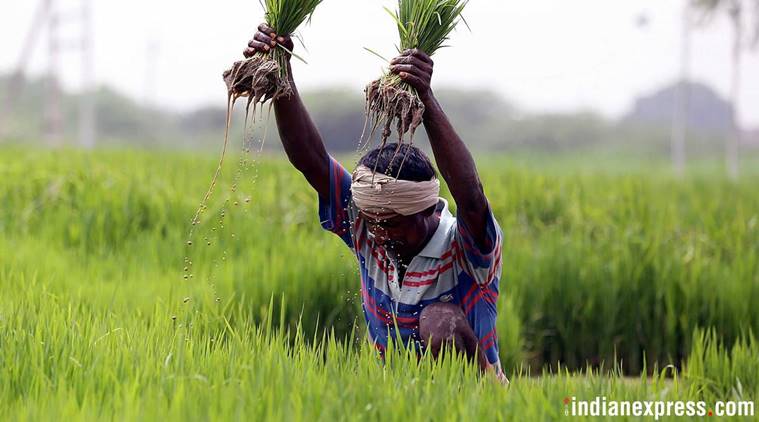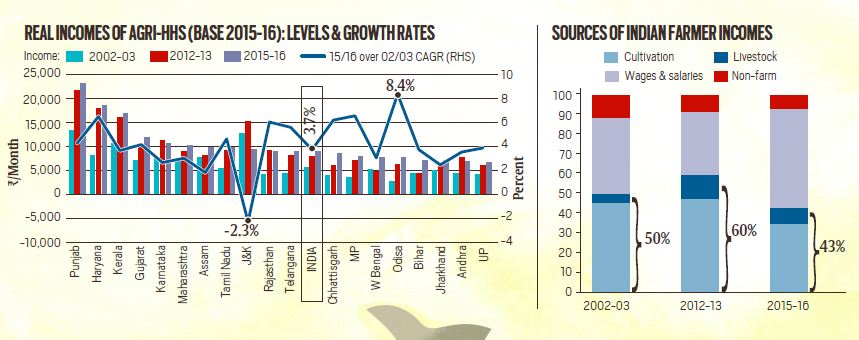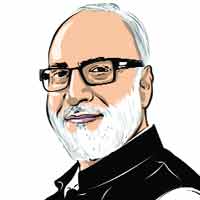From Plate to Plough: Lean year as a foundation
NABARD’s new survey offers a baseline to double farmers’ incomes. But is a survey done in a drought year a reliable yardstick?

NAFIS is based on a sample of 40,327 rural households in 29 states of which 48 per cent are agriculture households (agri-HHs); 87 per cent are small and marginal farmer households. (File)
On August 16, NABARD presented the nation with a gift when it released the results of its All India Rural Financial Inclusion Survey (NAFIS). Among other things, the survey estimates 2015-16 farmers’ income levels. In February 2016, when Prime Minister Narendra Modi presented his vision of doubling farmer incomes by 2022-23, there was no assessment of the base (2015-16) aggregate income levels. The estimates from NAFIS fill that gap.
NAFIS is based on a sample of 40,327 rural households in 29 states of which 48 per cent are agriculture households (agri-HHs); 87 per cent are small and marginal farmer households. The survey combines the strengths of the NSSO’s Situation Assessment Survey (SAS) and RBI’s All India Debt and Investment Survey.
Based on household-level data, NAFIS estimates that an average Indian farming household earned Rs 8,931/month (Rs 1,07,172/year) in agriculture year 2015-16. This is up from Rs 2,115 earned in 2002-03 as per the NSSO’s SAS, implying a compounded annual growth rate (CAGR) of about 12 per cent in nominal terms and 3.7 per cent in real terms (2015-16 base) in 13 years. One must, however, be cautious when comparing the NSSO and NAFIS estimates. Because of a wider definition of rural areas, unlike NSSO, the NABARD survey includes areas that are bigger including Tier Three, Four and Five towns. At Rs 5,000, it has a higher threshold level of income from agricultural and allied activities compared to the NSSO’s threshold income level of Rs 3,000. This is likely to create an upward-bias in NAFIS’s estimates of farmers’ income. If NAFIS followed NSSO’s definitions, the 2015-16 estimate of farmers’ income would have been somewhat lower, and so would have been its growth rate (below 3.7 per cent).

The survey also estimates income of non-agri rural HH at Rs 7,269/month, more than half of which comes from working as wage labourers. The overall weighted average monthly income of a rural HH is found to be Rs 8,059. On the financial aspects of these rural agri-HHS, NAFIS found for the reference year that about 43.5 per cent borrowed money with average availed loan of Rs 1,07,083. More than 60 per cent of these HHs borrowed from institutional sources, 30.3 per cent from non-institutional and 9.3 per cent from both. Close to 56 per cent of loans were for non-agri purposes. More than half (52.5 per cent) of the agri-HHS were found to be indebted, with an average outstanding debt of Rs 1,04,602 for the year. Almost 88 per cent of all rural HHs had bank accounts, and their monthly consumption expenditure on food was 51 per cent of total expenditure.
What does this data mean for PM’s dream of doubling farmers’ income? The Dalwai Committee, set up in April 2016, to advise on the strategy to double farmers’ incomes by 2022, did not have any benchmark income levels for 2015-16. So, the committee derived them by applying yearly growth rates of state-wise net-state-domestic-product (NSDP) to the NSSO estimates of 2012-13 income levels. For 2015-16, the committee found that average Indian agri-HH earned about Rs 8,059/month. This estimate is lower than that of NAFIS at Rs 8,931.
In any case, to see what happened between 2002-03 and 2015-16, we compared nominal and real income levels and estimated state-wise growth rates. Figure-1 gives real income levels (at 2015-16 prices) for three years (NSSO’s 2002-03 and 2012-13 and NAFIS’s 2015-16) and growth rates for major states and all-India.
Comparing incomes, we find that Punjab with Rs 23,133 tops the list while UP with Rs 6,668 is at the bottom, with the all India average at Rs 8,931. In terms of CAGR, Odisha tops with 8.4 per cent, though from a low base, while Jammu and Kashmir with a 2.3 per cent is at the bottom, due to an abnormal drop in income in 2015-16. The All-India CAGR in farmers’ real income is 3.7 per cent, which is roughly same as the agri-GDP CAGR (3.6 per cent) during the same period.
In terms of sources of income, NAFIS offers interesting insights, particularly for the Dalwai Committee. NAFIS estimates that in 2015-16, 35 per cent of farmers’ income came from cultivation, 8 per cent from livestock, 50 per cent from wages and salaries and 7 per cent from non-farm sectors. The year 2015-16 was a second consecutive drought year (rainfall in 2014 was 12 per cent and in 2015 was 14 per cent below normal), and comparing it with NSSO’s 2012-13 structure, we find income share from cultivation and livestock fell from 60 per cent in 2012-13 to 43 per cent in 2015-16. (Figure-2). It appears that working as labourers is a fall-back option for average farmers in drought years. Besides, the increasing pressure as a result of shrinking average holding size (NAFIS estimates it at 1.1 hectares) is presumably forcing farmers to work as labourers to meet their needs. This is very different from what the Dalwai Committee assumes when it says that by 2022-23, 69 to 80 per cent of farmers’ incomes will accrue from farming and animal rearing.
Interestingly, all three surveys were conducted in years of deficit rainfall: Rainfall in 2002-03 was 19.2 per cent below normal, in 2012-13 it was 7.1 per cent below normal and 2015-16 it was 14 per cent below normal. One wonders whether these surveys capture the true picture of agriculture and farmers. Going forward, it would be better if NSSO and NABARD ensure that their next surveys belong to normal rainfall years.
To achieve PM Modi’s dream of doubling farmers’ incomes by 2022-23, the Dalwai Committee points out that farmers’ real incomes need to grow at 10.4 per annum, that is, 2.8 times the growth rate achieved historically (3.7 per cent). This sounds like a challenge of raising country’s GDP growth from 7.2 per cent to 20 per cent. Is this feasible? An evaluation of various government policies and programmes launched in the past three to four years, especially their implementation — be it crop-insurance, focus on irrigation (99 projects), new MSP formula of 50 per cent above A2+FLcost, etc — does not offer confidence that the dream of doubling farmers’ incomes can be achieved by 2022-23 or even by 2025. It can possibly be done by 2030, unless the government undertakes drastic steps to augment farmers’ incomes at faster pace.
Gulati is Infosys Chair Professor for Agriculture and Saini is senior consultant at ICRIER
For all the latest Opinion News, download Indian Express App
More From Ashok Gulati
- From Plate to Plough: Timidity and technologyVajpayee government’s decision to introduce GM cotton made India a leader in production of the crop. Can the Modi government give a green signal to…
- From Plate to Plough: The limits of MSPInstead of fiddling with procurement prices, government must devise an income policy for farmers...
- Resolving the farmer-consumer binaryReforms to domestic market regulations and direct benefit transfers for vulnerable sections of the population could be the win-win solution...







































No hay comentarios:
Publicar un comentario